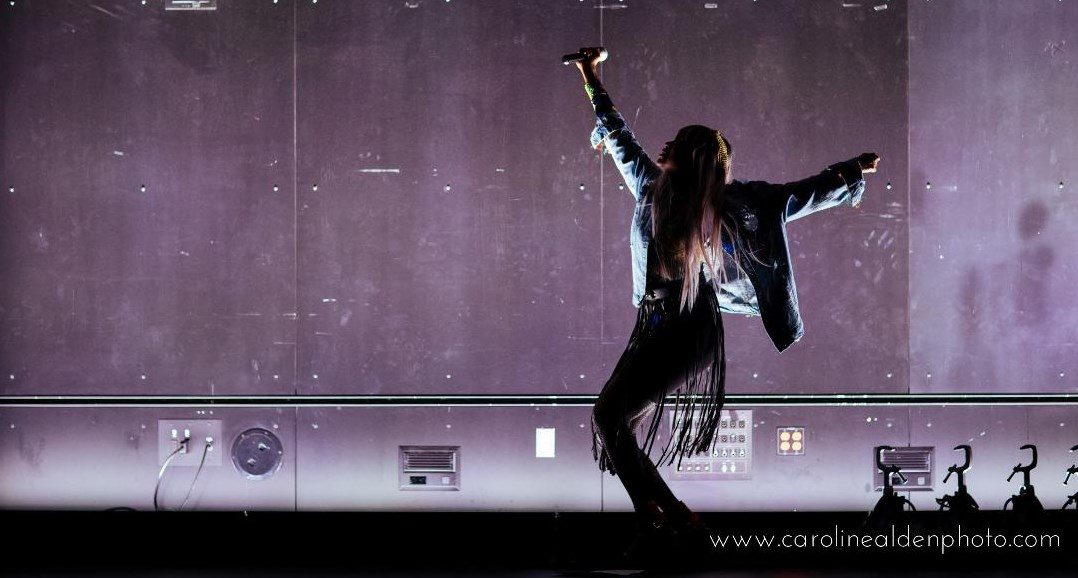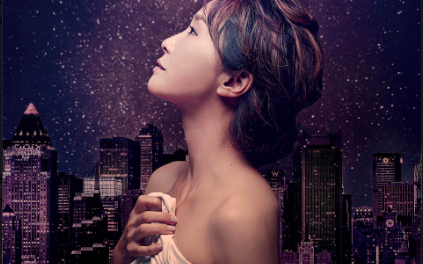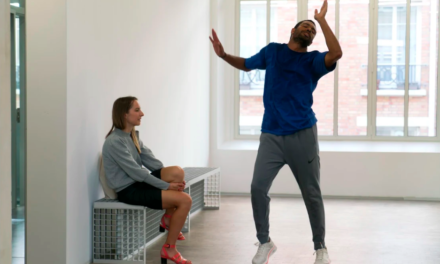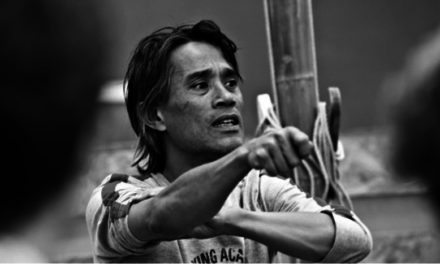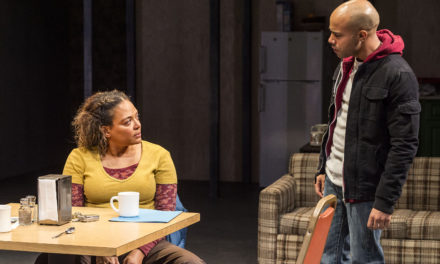Ayesha Jordan and Justin Hicks have been collaborators for many years. Their work transcends genres, borrows from various performance styles and disciplines, and provides a uniquely shaped social commentary on the most relatable issues. Justin Hicks is always learning more tools from all types of artists he works with: visual artists, dancers, actors. His art defies the boundaries of music proper. Ayesha Jordan creates and performs characters and narratives where the tropes of popular culture exist to challenge the complex and immediate politically and personally urgent context. I spoke to Ayesha and Justin shortly before the final showcase during their MIT residency.
Irina Yakubovskaya (IY): It seems like what you are working on right now is outside of the margins of genres. It is in a limbo neither there nor here. It’s almost a good side effect of a society where interdisciplinary art is becoming more visible. How does it feel to be sharing this work in progress during workshops and in particular your current MIT residency?
Ayesha Jordan (AJ): It is ok to be imperfect. It’s scary. Right now, were at the stage where we know the subject matter we’re dealing with but were still figuring out how we’re going to get from today to the show day in terms what that actually is going to look like. We’re literally building from scratch. The important thing is to show something in progess. It will help us in terms of the next stage of development.
Justin Hicks (JH): I love to share. As a musician, I come from a very mixed background of scenes and traditions, so that if something is finished it doesn’t really apply to me. I look at sharing as an opportunity to perform. Work in progress is a social thing to me. There’s a little bit of joy knowing they are not expecting so much, but they are possibly getting something out of it. We’re making a spell, a stew. People smelling a big pot of soup is very satisfying before it’s done. Sometimes the smell is the thing. This is how I look at presenting work in progress. I like people seeing us in various states of dress, in terms of the work. The work begins with the idea, and other people can come in and out. Sharing is an opportunity to be not fully clothed with people.
AJ: It is definitely more vulnerable.
JH: I don’t think so. In my journey with music, for example in the mid-1990s, people were dropping remixes all the time, and that to me is a level of finish. Is that done? Yes, because I can look it at and consume it. I love live recordings of things because there’s all this other ingredient around a rehearsal and the creation of something.
AJ: As an actor, the tricky thing is when you’ve been able to work the material for a consistent longer period of time, you have time to find things, to look for subtleties and nuances. When it’s something you’re just jumping into, there’s always uncertainty, there’s not the same level of confidence. But at the same time, there’s something that is more alive and fresh and raw and makes it exciting in the same way that you’re talking about these rehearsal recordings.
JH: On the level of performance it is different, when we’re in performance show mode it’s the certain kind of giving that does need rehearsal so that you can call it up. A lot of what we do, interdisciplinary work that uses music is hope that the score works. You hope that if we play this note here and this line is said here, and the light goes, it will create this thing that image that will create an emotional response. People need a lot to be given to them in order to have a realization. As a performer and musician, I have to be able to access this [energy] all the time. Even if I don’t have all the gear, and its still work in progress, it needs to show up. Why am I not watching this on Netflix, why did I leave the house [to see this show]? It’s about these combinations of ideas, forms, and music makes it compelling. It doesn’t have to be rehearsed to be compelling.
IY: You mention Netflix, which makes me think about the current trend of bringing live theatre on a TV or a big screen. How do you engage with technology in your work?
AJ: We use technology in a funny way. Especially as it relates to Shasta because she’s a pop star, which means social media, Instagram, all that stuff. We encourage people to take out their cell phones, take pictures, record and share it, post live videos. One, we’re playing with pop culture, how people exist now. And at the same time, there’s this aspect of connecting with people who are not in the space. Maybe even if they’re not there they’ll see someone who just posted this image of Shasta, #ShastaGoesPop. Live feeds during show are ridiculous, there are people shining their phones in your face, like a paparazzi thing.
JH: My notion of theatre when I was a kid was boring plays and musicals. There was part of me that was into this kind of stage work, and another part of me was into plain noise. I started wondering how to put this together. I think right now it’s an exciting relationship between screen television media and theatre, because I feel like live theater is borrowing from tv, and then tv is trying to get into riffing on the kitchen sink dramas. How close can we be to that person; can it feel like we’re really there? Even though in a theatre you are really there but there is this [distance], this tension of behavior. It’s all a mess, I definitely have mixed feelings about it.
JH: We keep things accessible. That’s the attitude in which we want people to consume the work. Be yourself here first, it will work out much better here for you if you don’t think you have to be in the theatre audience.
IY: Do you have a target audience?
JH: When we first started doing this show in places where we would get people beyond the usual initiated crowd, I always would hone in on an upper middle-class white dude who would be so into it, doing body rolls. This is very weird in the best way. There is something very escapist about what we are doing, but also, she is saying things. Things that are important about body politics, particularly in this last show. Together, these things worked for a lot of people.
AJ: I think the audience is automatically drawn to the show. I feel like between the two you can say late teens upwards to 70s. in terms of our demographic, definitely young people immediately connect to the work.
JH: Musically there was a wide range of eras. It was definitely 20th century stuff, almost everything we were using came from actual records. Like old school hip-hop style, and were making a beat out of it, some stuff was just running, an there were times where I felt like that sense of time period was really interesting and did let some people feel comforted. She also has a universal sense of humor and makes people feel safe laughing at themselves. Insecurely Me is this tune that’s hilarious. It gets into the mechanics of situations, like “I smell bad, and I want to talk to this person.”
AJ: Or I like this guy and I’m talking to him up close and my breath stinks, I got to breathe inwards.
JH: All these micro moments we all deal with. When those things land on people, everybody of every age acknowledge “we’ve all been there.”
AJ: When we did our performances in the lobby [of the Public], it was around the time when all these festivals were going on. Theatre demographic is very specific. when we did it at the highline, it was a totally different experience. There were people who were walking down the street. Ideally, we would love to have more people of color. It would be great to have more poc in the audience, I think that because most of us who are working on the projects are African American or Caribbean American …
JH: Basically, it’s a little club of folks who know what its like to be othered. It’s a team that doesn’t necessarily reflect the theatre audience or even theatre administration. None of us are academics in that way. People come to see theatre are the initiated whether they are rich or poor–they’re theatre heads. Our audiences come because they love performance. When we’re in a performance venue that’s our audience all the time. That audience has access to knowing or has a little bit of money to see performances.
When you’re talking as this body, addressing things through that filter you want to have some sort of commutation band you want it to be safe for you.
AJ: I want people who can recognize the references. If I’m doing a song and you know the reference then a conversation happens, an understanding. If you grew up going to the clubs with certain kind of music and you know when everybody starts making the same one movement, it’s a certain language that everybody understands. Half people in the audience reflect your experience and you get this conversation, but half isn’t that. It enhances the performance for me, because I don’t see the audience members as audience, they’re participating. Its nice to have participants who understand a lot of the language. And support what’s happening.
JH: Especially with the Shasta show, since it is very interactive. There’s something about proximity that’s so important. Having people who know what it’s like to be any other people generating that world, help us reinforce the ideas, put bodies in the audience that can bounce that energy in the audience.
IY: Even maybe get inspired.
JH: It comes back to be willing and eager to share. Sometimes things happen during the show, and [certain bothersome behaviors] serve as illustrations of the theme of a song or the show overall.
IY: How do you feel walking that line of interactive performance?
AJ: I love it, it’s a comfortable space for me. I am more into it than rehearsing. It is hard for me to come up with material, that riff and interact with the audience. The development is the hardest part of the process. Its finding things and deciding what to do.
JH: It’s deciding how to say it. We have strong ideas and interesting nuanced jumping points. I think this week we want to cast a little bit of a spell and see if we can make that work for a time. Even if this is work in progress the audience is very important to us in being able to get to the next phase.
AJ: I want to challenge the audience, but I also want them to feel safe. I want to go to a show to feel like I’m going to be assaulted or to do something I don’t want to do. Don’t ask me to clap my hands right now, I don’t feel like clapping my hands. For me, as an artist, it’s important to be sensitive and to take the time to create a transformation, and then you can see who is ready.
JH: What we’re interested in right now is a little bit more reflection. I see it as a culturally specific place, and there will be some specific references. It’s not necessarily about this all-inclusive thing that gets to happen. This stuff is codified in a way that can be cold. We want to warm it up.
IY: Give me an example.
AJ: Without giving too much away…for example, addressing cultural appropriation. There’re different types. Mardi Gras Indians for instance. They dress up in garb that is very reflective of Native Americans, and it’s literally a translation of those aesthetic ideals. The tradition has been around for over a century but its directly connected to the real historical exchange. There’s a direct tie between the two cultures. It keeps it from being cultural appropriation in the negative sense of the word.
JH: There is a lot of really affective appropriated artwork. It is important to know that the Mardi Gras Indians verbalized and acknowledged their process. They shared and used it consciously to tell their story. It is a moment of giving and taking, and also paying it back while looking forward.
AJ: There is a direct exchange. It’s tricky. Nowadays there’s so much cultural appropriation going on, it is offensive in pop culture. It is interesting that Shasta is the vessel to tell this particular story.
JH: There’s so many things out there that are combined and rehashed and reassembled with other things, this is the nature of how things get into us, how we make things, think about things. How we deal with time. To me, this conversation about cultural appropriation goes a little bit further in that it’s a little bit hurtful to think that people want what you’re producing whether that’s as simple as how you’re wearing your jeans. You could be nobody and Levi’s will know how to advertise your jeans better than you because you looked a certain way. How can it be that you can produce and include people and give and give and give, or be seen and watched and monitored, and these things get extracted from you that people don’t want to deal with your body and your presence. We can be in the same space in the theatre, and it always feels relevant. Where I am, it’s very important. How do I make my participation in these traditions clear that also leads to some other exchange? Rather than making something that sounds like something that people will like and eat.
The tradition of the Mardi Gras Indians is founded on sharing. They don’t take [the Native American culture] to own it, but rather they share it.
IY: Taking other people’s ideas and appropriating them is a colonial act rooted in the idea of ownership. Borrowing, interpreting, riffing off of, and sharing ideas is an act of collective creativity, like the jazz method. Taking and owning is a colonial gesture.
JH: Yes. And we are not exempt from it or above it. There’s also this real beautiful thing that happens especially I think between othered people. If you know someone who’s got a little bit of something-something going on, sometimes it’s a look in the eye, sometimes it’s just what they have on, we all have those little markers. People wear a bracelet, it’s supposed to be a signal of their ideals. These are supposed to be safer nowadays.
IY: I would love to hear more about Shasta.
AJ: She’s crazy shews loving, she’s a pop diva superstar. Shasta is this pop star who loves to make people laugh but she also loves to make us sit in her fabulosity. Her origins are in Louisiana, but she hasn’t been there in forever. She’s been in New York and traveling the world. I think that she’s vibrant and colorful but also very sensitive and vulnerable. I always picture a Barbie doll what they would feel like if they would’ve been played with for years and years and then all of a sudden, they’re in a box. There’s a piece of Shasta that feels like that Barbie in a box. But she is not in the box.
JH: She’s not completely discarded. Somebody might sell her on eBay.
AJ: What happened is somebody sold her on eBay, she has a new home, but she has to express this part of her that was like discarded. Shasta speaks to that part of us that we tuck away, that were scared to talk about.
JH: Don’t tell Shasta, but I imagine her as this: Brandy and Monica had a feud, and one of them got more famous, and she is the less famous but more talented one. There’s something about Shasta that is trustworthy and giving. But also, fun to watch.
AJ: She likes life, she loves pizza, she loves sex, she’s all about educating people about Kegels.
JH: She is like a cousin who got famous…
AJ: …but she’ll still show up at the family reunion.
IY: She seems truly wonderful. I would love to see Shasta host the Oscars.
This post was written by the author in their personal capacity.The opinions expressed in this article are the author’s own and do not reflect the view of The Theatre Times, their staff or collaborators.
This post was written by Irina Yakubovskaya.
The views expressed here belong to the author and do not necessarily reflect our views and opinions.

